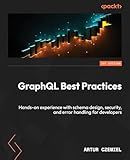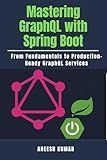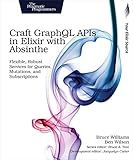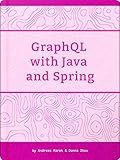Best GraphQL Integration Tools to Buy in December 2025

GraphQL Best Practices: Gain hands-on experience with schema design, security, and error handling



Mastering GraphQL with Spring Boot: From Fundamentals to Production-Ready GraphQL Services



Craft GraphQL APIs in Elixir with Absinthe: Flexible, Robust Services for Queries, Mutations, and Subscriptions



GraphQL with Java and Spring



REACT NATIVE: Scopri la guida completa alla programmazione di siti internet e web app con ReactJs, costruisci soluzioni scalabili con GraphQL e sviluppa applicazioni Full Stack. (Italian Edition)


To connect MongoDB with GraphQL without using Mongoose, you can utilize the MongoDB Node.js driver along with a GraphQL server like Apollo Server or GraphQL Yoga.
First, you would need to establish a connection to your MongoDB database using the MongoDB Node.js driver. You can create a new instance of MongoClient and use the connect method to connect to your database.
Once your connection is established, you can define your GraphQL schema using the type definitions and resolvers. You can create queries and mutations that interact with your MongoDB database directly using the MongoDB Node.js driver within your resolvers.
For example, you can use the MongoClient instance to query your MongoDB database and return the results in your GraphQL resolver functions. You can also perform CRUD operations such as inserting new documents, updating existing documents, and deleting documents using the MongoDB Node.js driver within your resolvers.
By integrating the MongoDB Node.js driver with a GraphQL server, you can create a powerful and flexible API that allows you to interact with your MongoDB database using GraphQL without the need for an ORM like Mongoose. This approach gives you full control over how you interact with your data and allows you to leverage the strengths of both MongoDB and GraphQL in your application.
What is the difference between using Mongoose and connecting MongoDB directly with GraphQL?
Mongoose is an Object Data Modeling (ODM) library for MongoDB and provides a higher level of abstraction when working with MongoDB databases. It allows developers to define schemas, models, and interact with data using JavaScript objects.
On the other hand, connecting MongoDB directly with GraphQL involves writing custom resolvers and queries to interact with the database. This approach requires more manual coding and does not provide the same level of abstraction and convenience as using Mongoose.
In summary, using Mongoose with GraphQL simplifies the development process by providing a higher level of abstraction for working with MongoDB databases. It also offers features such as data validation, middleware, and query building that streamline the development process. Connecting MongoDB directly with GraphQL requires more manual coding and does not provide the same level of convenience and features as using Mongoose.
What are the best practices for connecting MongoDB with GraphQL without Mongoose?
- Use a GraphQL server that supports MongoDB directly, such as Apollo Server or graphql-yoga, which have built-in support for MongoDB.
- Set up a MongoDB client in your server code to connect to your MongoDB database.
- Create resolvers in your GraphQL server that interact with your MongoDB client to perform CRUD operations on your database.
- Use GraphQL schema stitching or schema delegation to combine your MongoDB resolvers with other resolvers in your GraphQL server.
- Use GraphQL subscriptions to subscribe to changes in your MongoDB database and update your GraphQL clients in real-time.
- Optimize your queries by using GraphQL query batching and caching to reduce the number of requests to your MongoDB database.
- Use indexes in your MongoDB database to optimize query performance for common GraphQL queries.
- Implement error handling in your resolvers to handle any errors that may occur when interacting with your MongoDB database.
- Consider using a library like graphql-compose-mongoose to generate GraphQL types and resolvers from your MongoDB schema if you decide to use Mongoose in the future.
- Test your GraphQL resolvers thoroughly to ensure they work correctly with your MongoDB database.
How to establish a connection between MongoDB and GraphQL without using Mongoose?
To establish a connection between MongoDB and GraphQL without using Mongoose, you can use the native MongoDB Node.js driver along with a GraphQL server library such as Apollo Server.
Here is a basic outline of the steps to do this:
- Install the necessary packages:
npm install mongodb apollo-server graphql
- Create a MongoDB client and connect to your database:
const { MongoClient } = require('mongodb');
const client = new MongoClient('mongodb://localhost:27017', { useUnifiedTopology: true, });
(async () => { await client.connect(); console.log('Connected to MongoDB'); })();
- Define your GraphQL schema and resolvers using Apollo Server:
const { ApolloServer, gql } = require('apollo-server');
const typeDefs = gql` type Book { id: ID title: String author: String }
type Query { books: [Book] } `;
const resolvers = { Query: { books: async () => { const db = client.db('your_database_name'); const booksCollection = db.collection('books');
return await booksCollection.find().toArray();
}
}, };
const server = new ApolloServer({ typeDefs, resolvers });
server.listen().then(({ url }) => { console.log(`Server ready at ${url}`); });
- Run your server and test your GraphQL queries:
node index.js
You can now send GraphQL queries to your server using a tool like GraphiQL or Apollo Playground to interact with your MongoDB data without using Mongoose.
How to handle concurrency and locking issues with MongoDB data in GraphQL without Mongoose?
When working with MongoDB data in GraphQL without Mongoose, it is important to handle concurrency and locking issues to ensure data consistency and prevent race conditions. Here are some approaches to handle concurrency and locking issues in a GraphQL application using MongoDB:
- Optimistic concurrency control: One approach to handle concurrency in MongoDB and GraphQL is to use optimistic concurrency control. Optimistic concurrency control involves adding a version field in the MongoDB documents that gets incremented each time the document is modified. When a client makes a modification request to the server, the server can check if the version of the document being modified matches the version sent by the client. If the versions match, the modification is allowed, but if they don't match, it indicates that the document has been modified by another client and the server can reject the modification request.
- Use transactions: If your MongoDB deployment supports transactions (such as MongoDB 4.0 and later), you can use transactions to handle concurrency and locking issues. Transactions allow you to group multiple operations together and execute them atomically, ensuring that either all operations succeed or none of them are applied. This can help prevent race conditions and ensure data consistency when working with MongoDB data in a GraphQL application.
- Implement custom locking mechanisms: Another approach to handle concurrency and locking issues in MongoDB and GraphQL is to implement custom locking mechanisms in your application code. You can use locks to prevent multiple clients from modifying the same document simultaneously, ensuring that only one client can modify a document at a time. However, be cautious when using locks, as they can introduce performance overhead and potential deadlocks if not implemented carefully.
- Handle conflicts gracefully: In cases where conflicts do occur due to concurrent modifications, it is important to handle them gracefully in your GraphQL resolvers. You can implement conflict resolution strategies such as last-write-wins or merging conflicting changes based on specific criteria. By handling conflicts gracefully, you can ensure that data consistency is maintained and prevent data corruption in your MongoDB database.
By implementing these approaches, you can effectively handle concurrency and locking issues when working with MongoDB data in a GraphQL application without relying on Mongoose. It is important to carefully consider the requirements of your application and choose the appropriate approach that fits your specific use case.
How to implement caching for MongoDB data in GraphQL without using Mongoose?
To implement caching for MongoDB data in GraphQL without using Mongoose, you can use a caching library like Redis or Memcached. Here is a general approach to implementing caching in GraphQL with MongoDB:
- Set up a cache store: First, you will need to set up a cache store such as Redis or Memcached. These cache stores will store key-value pairs that represent MongoDB data that has been fetched previously.
- Implement a caching layer in your GraphQL server: Within your GraphQL server, you will need to implement a caching layer that will check the cache store before querying the MongoDB database. If the data is found in the cache store, it can be returned directly to the client without having to query the database.
- Cache data after querying MongoDB: Whenever you query the MongoDB database for data, you should cache the results in the cache store using a unique key that represents the query parameters. This will allow you to quickly retrieve the data from the cache store in the future without having to query the database again.
- Set cache expiration times: To ensure that your cache remains up-to-date, you can set expiration times for the cached data. This will help prevent stale data from being returned to clients.
- Invalidate cache on data mutations: Whenever data is mutated in the MongoDB database (e.g., inserting, updating, or deleting data), you should invalidate the corresponding cached data in the cache store. This will ensure that clients always receive the most up-to-date data.
By implementing a caching layer in your GraphQL server using a cache store like Redis or Memcached, you can improve the performance of your application by reducing the number of database queries and improving response times for clients.
